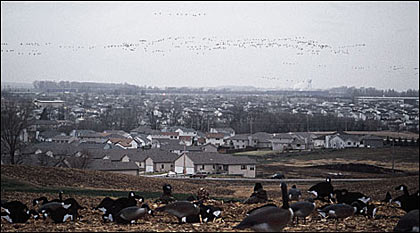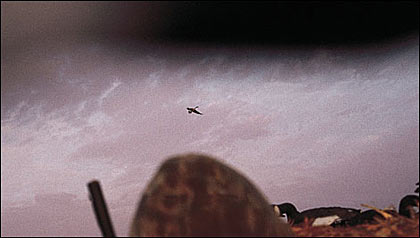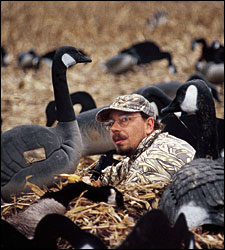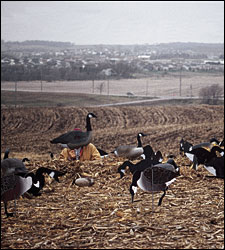November 03, 2010
Urban vistas and resident winter geese provide opportunity and challenge in the famed clinic town
 Some 35,000 to 40,000 Canada geese congregate within the city limits of Rochester, Minnesota, feeding in fields on the outskirts of town. |
Above the horizon in a golden morning mist, the sky seemed filled with geese; small bunches, little flocks, big clouds, in fact, thousands of Canadas flying in every direction. Below the horizon was a thriving community, replete with houses, concrete streets, and people driving to work on an early morning in mid-November.
For those who live in Rochester, Minnesota, a sky full of giant Canada geese is a common sight. The birds draw close attention from city residents only when something wet, white, and a little smelly splats on a windshield or sticks to a shoe sole. However, for a limited few who reside in Rochester, and for a large number of visitors, the numbers of the big geese and their flight patterns are of major interest. Those who hunt these Canada geese and those who guide the hunters to them, closely watch the birds from nearby grain fields, weedy fence-lines, road-side blinds, and any other place where the big waterfowl regularly fly and can be legally hunted.
Advertisement
The whole town of Rochester is a state game refuge, a fact reflected in the huge numbers of waterfowl that roam the streets, lawns, backyards, and public parks of the city. Central to the creation and stability of this Canada goose population is Silver Lake, a man-made impoundment of several hundred acres built by the Mayo brothers back in the 1930s. The two main claims to fame in Rochester, in fact, were created by the Mayo's: one is the world renowned medical facility that bears their name and the other is Silver Lake, a community where flocks of Canada geese dominate from October throughout the rest of the fall and into winter.
In a 180-acre field of corn stubble on a hill overlooking the town of Rochester, 10 hunters hunkered down in plywood-walled pits and watched the rising sun burn into the mid-November haze. Twenty minutes before dawn, a flock of 100 big Canadas flew across the city skyline, pumping hard from the direction of Silver Lake and straight into the direction of a big field of cut corn--located in the city limits and within the state game refuge.
Advertisement
 Though the field pits in Rochester are better than laying on the bare ground, they offer little overhead cover. |
Other flocks, big and small, soon followed, and I experienced that "oh, ooh" feeling, a sense that the flight pattern might turn this day into a bird watching event rather than a goose hunting experience. It's happened before to me and it could happen again.
"Don't worry," Jeff Bruns, head guide of Premier Flight Guide Service, assured me. "Not all the geese in town can fit into that field€¦. In a while some will come our way."
As if waiting for this cue, a trio of honkers suddenly appeared and headed in our direction across the rooftops of apartment houses a half-mile away. In the pits on our hilltop, five hunters start calling and blowing hard, long and loud, using every goose note and tune in the Canada songbook. "Power calling," is my term for the raucous; high volume imitation of a flock of honkers deliriously happy while feeding in a cut cornfield.
 Though hunters can easily "free lance" on their own in the area around Rochester, most visitors usually sign up with one of the half dozen local guide services for a day or two of field hunting. |
Surrounded by 300 Canada decoys, we watched and waited as three big birds looked over the full bodies, silhouettes, homemade V-boards, flying Decoys and flagging. Liking what they saw and heard, the geese kept on coming.
A piercing buzz rose amongst the constant fervor of calling. Jeff Bruns had hit the button that signaled the hunters to roll back the wooden doors that acted as pit covers. In a volley of gun thunder, two geese folded. A third set its wings, glided, and then crashed a hundred yards away, with a thump and a puff of feathers. Not a bad start to my two-day Rochester-area goose hunt.
All morning, right up to the noon hour, the scene repeated itself in our field and in other similar fields on all sides of Rochester. There were few lulls as the birds traded back and forth between food and water. The big flocks stuck to the big fields within the refuge; but every so often, at least once an hour, a single, a double, a trio, or a small batch of geese would break off and come to our calling and our decoys. By noon, each gunner had at least one bird of a two-bird limit to carry back to his vehicle.
"Our guide service averages one goose per gunner throughout the season," Jeff Bruns said. "Some days, especially toward the middle of November, are usually better, when the migration is at its peak and new geese arrive daily. Cold, windy weather can produce some good hunting conditions because the geese will fly longer throughout the day. But even the warmer, calmer days in November and December have been productive if the population of Canadas hits and holds at 35,000 to 40,000," Bruns added.
 When hunting from a field pit, one method of hiding from incoming geese while still seeing them clearly utilizes the Heads Up Decoy. |
How do the other residents of Rochester view the goose hunting? "The vast majority of people who live here are tolerant of the goose hunting and, like most small-town Midwestern folk, understand that hunting is the best way to manage the overall goose population," Bruns said. This attitude seems well supported by a local citizenry who enjoys seeing the big birds fly across the skyline, but know there can be a problem when surplus geese start camping on lawns, overcrowd parks, take over golf courses, create traffic hazards and become a serious social issue.
"How cruel!" a woman, driving a van with a Massachusetts license plate, said one afternoon as she watched hunters carrying newly bagged geese through the parking lot of a Rochester McDonalds.
"How so?" I asked.
"Those are the same geese I fed by hand in the park yesterday€¦. And today you guys killed them€¦. How sporting could that be?" she added.
| The Four Ws | 
 |

Who to see: To schedule a goose hunt with Premier Flight Guide Service, call (888) 354-4484. If Premier Flight's bookings are full, it can arrange hunts with any of the five other guide services in the Rochester area. They are:
Final Approach; (507) 367-2374; Steve Reese
North Flight; (800) 860-6907; Rick Billings
H and Q; (507) 281-4708; Gary Quanelt
Westline; (507) 282-8375; Todd Fanning
Folding Feathers; (507) 288-0089; Steve Smith
When to come: Though the first two weeks in November is the peak for Rochester Canadas, plenty of geese will be around in late October and from mid-November to the end of the season in December. Newly arrived birds are the easiest to call and decoy. By late November, most of the honkers in the region have seen plenty of hunting. That's when a guide's skills are put to the supreme test.
What to bring: Warm clothes and 12 gauges with 3" magnums or even 10 gauges that shoot BBs and BBBs. Most shots over decoys will start at 20 yards and extend to 40, but the shooting can be fast, furious and occasionally a little difficult from ground blinds with rolling pit covers. Most blinds will have propane-fired heaters for below freezing weather.
What to expect: No matter when you come to Rochester, you will see geese flying every day, sometimes all day. Not every flock, however, will come to the decoys and the calling, no matter how good. Those hunters who are patient and who pay attention, however, will get some good shots and will take some trophy Canada honkers home with them.
|
|
"The same geese? I don't think so," Jeff Bruns later said when I told him of this parking lot incident. "The vast majority of these honkers are born in Canada and have been migrating through here for decades. As to the sporting question, I'll argue that there are no wilder geese anywhere€¦. That's why we have to do so much good calling and use so many good decoys. Even then we feel lucky when we get a limit. We work hard and use a lot of skills to get these geese€¦they don't just fall out of the sky by accident."
Definitely Giants
Though almost all the geese taken by hunters in the Rochester area are big, one out of 30 or so will go 12 pounds or heavier. Katie Bartz of Eagan, Minnesota, shot her first goose just outside of Rochester on a mid-November hunt, a bird definitely in the trophy category. Big geese like this are the giant race of Canadas that nearly disappeared but were rediscovered in the Rochester area. The "giants" breed in a specific area of Manitoba and many from this population winter in the Rochester area. Jeff Bruns has two big Canadas that weigh in the 10-pound plus category. "Every year we shoot a few Canadas at 14 pounds or more," Bruns said.
Goose Music
"Goose music" I called it, though the guys who make the serenade and play the tunes acted a little embarrasseded when I used the phrase to describe the honks, the clucks, the moans, and all the other goosey notes they created when a flock of Canadas came into view. To most good goose callers, the sounds they created were strictly utilitarian, a practical way to hover geese over decoys, to lower them over a weedy fenceline, or to otherwise bring them into shooting range.
Practical yes, but pretty too, especially when a half-dozen champion callers and contest winners teamed up to talk to geese a half-mile away, bringing in a flock of 12 on cupped gray-white wings, with big black feet in landing position.
Adam Rametta of Murphysbore, Illinois, a 1994 World Goose Calling Champion, makes "goose music" for Premier Flight Hunting Service in Rochester, Minnesota. He uses a "Half Breed" and a "Magnum Clucker" both made by Tim Grounds of Johnston City, Illinois.
"The best call for Rochester geese is the sound made by a combine cutting its way through an un-harvested cornfield," said Jim Mattson, Minnesota State Goose Calling Champion, local long-time hunting guide, and owner of Midwest Waterfowl Supply in Rochester. "Some day, I'm going to borrow a combine, drive it down to Silver Lake, and get all the geese there to follow me out to a cornfield outside of town where we'll have our decoys set€¦. I'll be known as the Pied Piper of Rochester, Minnesota," Mattson added, with a smile.
Mattson is one of a large contingent of contest-winning, goose-hunting guides from the Rochester area. Like many of his calling colleagues from the area, he grew up listening to the big resident Canada honkers at Silver Lake. "The Lake is a good place to learn how to call," he said, "because some geese are there all year long and, in the fall and winter, they are there by the thousands." Most of the guides and many of the local hunters from the area have had the same kind of up-close-to-the-geese experiences.
"In early to mid-November, nearly everyone can be a productive caller," Mattson said, "because that is when the corn is being harvested and the new geese are migrating here from Canada. Out in a newly harvested cornfield, just about anyone who sounds even remotely like a goose can sucker hungry honkers to a decoy rig€¦. It's later in the month and in December that good calling really counts because by then the birds have heard all kinds of calling and been exposed to plenty of shooting.
"Late in the season only smart geese are left," Mattson continued. "They tend to fly in larger flocks, go to new fields farther from town, and are very careful about where they land. Mediocre calling will produce few results," Mattson added. "The high volume 'power' calling that brought in small bunches in late October and early November must now be replaced with 'finesse' calling that is a lot quieter and more subtle. The noisy racket of three or four hunters doing loud honks and rapid clucks with noisy moaning and whining might turn a flock. But, when the birds get up close, 'low and slow' is the key to bringing them into the decoys."

